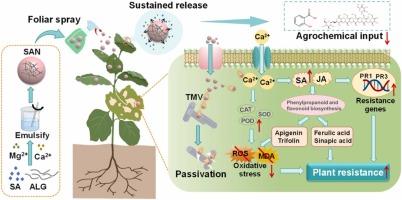Salicylic acid-functionalized nanogels enhance tobacco mosaic virus resistance and alleviate oxidative stress in crops
IF 6.2
1区 农林科学
Q1 AGRICULTURAL ENGINEERING
引用次数: 0
Abstract
Tobacco mosaic virus (TMV), one of the most devastating plant pathogens worldwide, causes catastrophic agricultural losses. While chemical pesticides remain primary method for controlling viral diseases, their improper use poses significant ecological risks, including environmental persistence and biomagnification. Herein, we employed a nanogel carrier to encapsulate salicylic acid (SA), creating a green nanobiostimulant termed salicylic acid-functionalized nanogels (SAN). This SAN exhibited excellent stability, strong foliar adhesion, a favorable slow-release profile, and high biosafety for tadpoles. Foliar application of 50 mg/L SAN resulted in a higher control efficiency against TMV in tobacco (Nicotiana tabacum L.) plants than that of SA or lentinan (LNT, a commercial biostimulant) alone, and the disease severity of SAN was significantly reduced by 29.6 % and 20.5 % compared with SA and LNT, respectively. Mechanistically, 50 mg/L SAN directly inactivated TMV by causing the aggregation and fracture of TMV particles. Furthermore, SAN indirectly induced tobacco plant resistance to TMV via activating endogenous signaling (Ca2 + influx and phytohormone accumulation), upregulating the expression of key genes for disease resistance (e.g., PR1, PR3), and enhancing defense metabolites involved phenylpropanoid pathway (e.g., chlorogenic acid, ferulic acid, rutin). Moreover, SAN significantly mitigated tobacco leaf oxidative stress by increasing the activity of antioxidant enzymes (SOD, POD, CAT) and the production of flavonoids, and such effect was better than that of SA and LNT. Overall, SAN is a promising eco-friendly nanobiostimulant with the potential to replace conventional biostimulants and pesticides for sustainable disease control in agroecosystems.

水杨酸功能化纳米凝胶增强烟草花叶病毒抗性,缓解作物氧化应激
烟草花叶病毒(TMV)是世界上最具破坏性的植物病原体之一,造成灾难性的农业损失。虽然化学农药仍然是控制病毒性疾病的主要方法,但不当使用会造成严重的生态风险,包括环境持久性和生物放大性。在此,我们采用纳米凝胶载体封装水杨酸(SA),创造了一种绿色纳米生物刺激剂,称为水杨酸功能化纳米凝胶(SAN)。该SAN具有良好的稳定性、较强的叶面粘附性、良好的缓释特性和对蝌蚪的高生物安全性。叶面施用50 mg/L SAN对烟草TMV的防治效果优于单独施用SA或香菇多糖(LNT,一种商业生物刺激素),且SAN的病重较SA和LNT分别显著降低29.6 %和20.5 %。机理上,50 mg/L的SAN通过引起TMV颗粒的聚集和断裂直接灭活TMV。此外,SAN通过激活内源信号(Ca2 +内流和植物激素积累),上调抗病关键基因(如PR1、PR3)的表达,以及增强苯丙素途径(如绿原酸、阿威酸、芦丁)的防御代谢物,间接诱导烟草植株对TMV的抗性。此外,SAN通过提高抗氧化酶(SOD、POD、CAT)活性和黄酮类化合物的生成,显著缓解烟叶氧化应激,且效果优于SA和LNT。总的来说,SAN是一种很有前途的生态友好型纳米生物刺激素,有可能取代传统的生物刺激素和农药,在农业生态系统中实现可持续的疾病控制。
本文章由计算机程序翻译,如有差异,请以英文原文为准。
求助全文
约1分钟内获得全文
求助全文
来源期刊

Industrial Crops and Products
农林科学-农业工程
CiteScore
9.50
自引率
8.50%
发文量
1518
审稿时长
43 days
期刊介绍:
Industrial Crops and Products is an International Journal publishing academic and industrial research on industrial (defined as non-food/non-feed) crops and products. Papers concern both crop-oriented and bio-based materials from crops-oriented research, and should be of interest to an international audience, hypothesis driven, and where comparisons are made statistics performed.
 求助内容:
求助内容: 应助结果提醒方式:
应助结果提醒方式:


